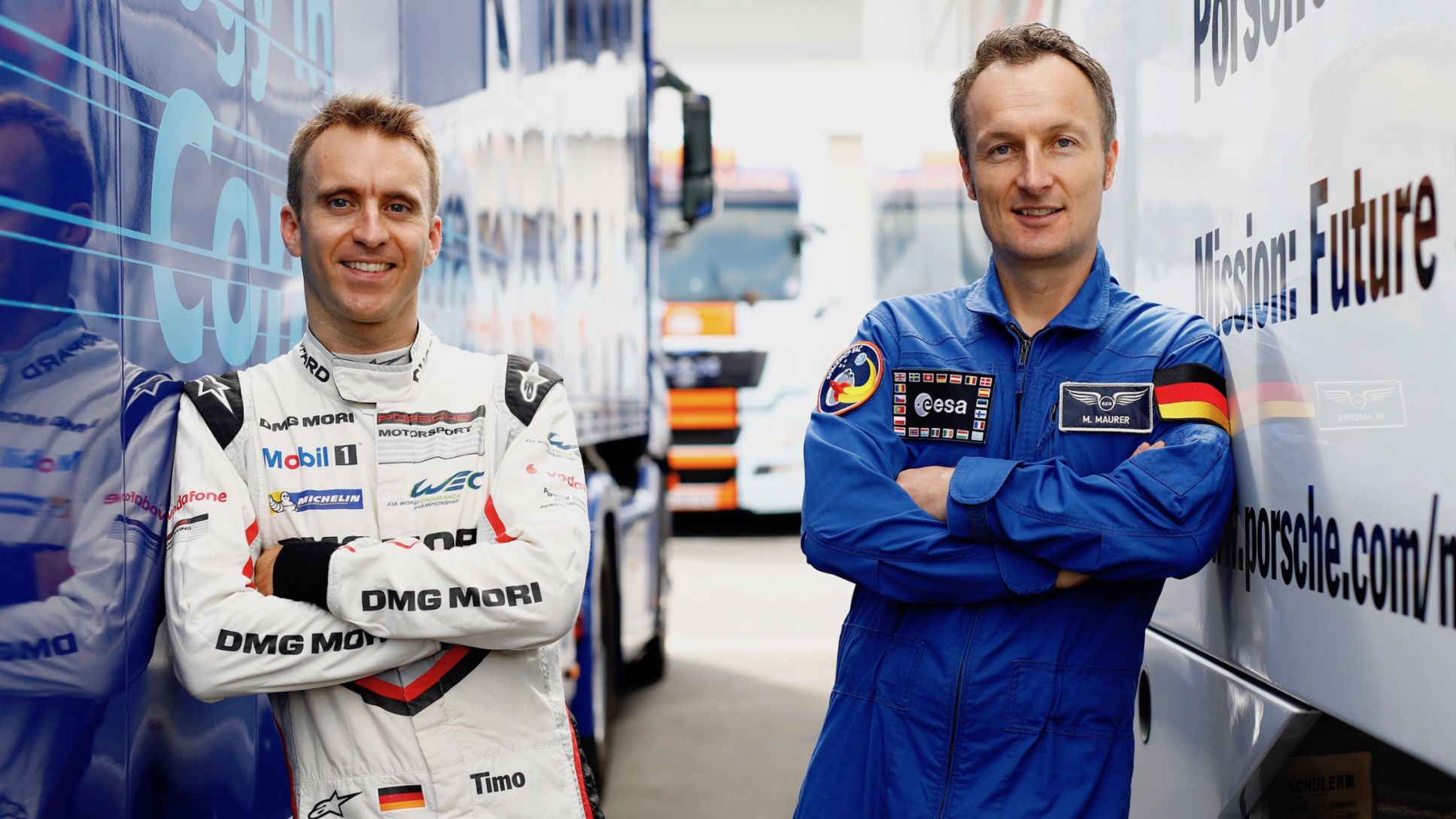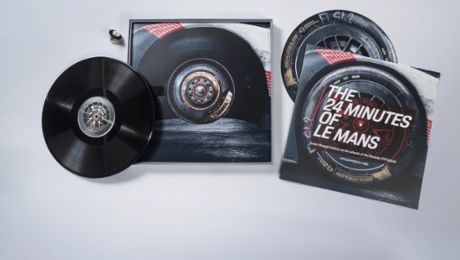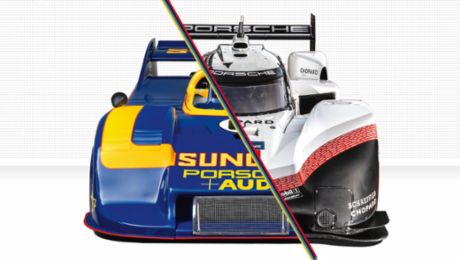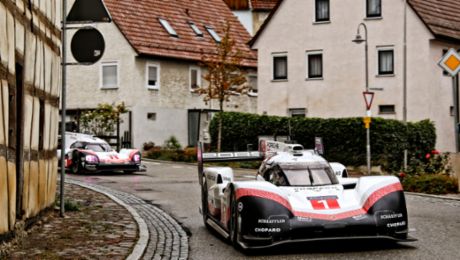Timo Bernhard is accustomed to situations of which others can only dream. Not just children playing Top Trumps, but also many adults in later life. To drive just once along the ‘route départementale’ D338 in the west of France. Once along the Mulsanne Straight, preferably at night, preferably in a racing car, the speedometer needle above 330 km/h. For Bernhard, 36, this is all part of his job. He is a two-time victor of the 24 Hours of Le Mans – one of the three most famous car races in the world, and far tougher than the other two, the Indianapolis 500 and the Monaco Grand Prix.
A few weeks after his second Le Mans victory, Bernhard stands in front of his racing car, a Porsche 919, four-cylinder, hybrid drive with around 900 hp. It is a car so complex that the sums of money spent on its development and operation could finance an entire season of Formula 1. Bernhard is trying to explain the cockpit – the steering wheel, the view of the world from the driver's seat, the racetrack out there – in which he accelerates from zero to 100 in 2.2 seconds, and to 200 in 4 seconds. But the person he is trying to impress, has his own staggering numbers to report. “We reach speeds of 28,000 km/h in nine minutes”, says Matthias Maurer.
Matthias Maurer, 47 years old, and – like Bernhard – born in Saarland, is an astronaut, and the next German who will fly into space. In February, he was introduced as a new member of the European Astronaut Corps for the ESA. From the Kazakh Steppe towards the stars, at a speed of 28,000 km/h, strapped into a rocket filled with 200 tonnes of highly explosive fuel until it docks at the outpost of humanity in space at the International Space Station (ISS) – at some point, it will be his turn. When? Maurer does not know yet: “It has not yet been decided whether the flight will be in 2020, 2021 or 2022, but one of the available spots will be for me.”
How will you feel when the capsule takes off and you see the universe?
Maurer: You try to imagine a few things, of course. To sit in such a rocket, to feel the acceleration as it takes off, to look out of the window, to see the earth below you, very small ... and then, of course, to know: I am now in space. I have been preparing myself for this for years. By my definition, you’re not a real astronaut until you have been into space. A racing driver, who practises in the simulator for ten years, but has never been on the race track, is not ...
Maurer does not finish the sentence but it is reminiscent of the famous quote by racing driver Michael Delaney: “When you’re racing, it’s life. Anything that happens before or after is just waiting.” Delaney is the Porsche driver played by Steve McQueen in the 1971 film “Le Mans”. A Hollywood statement that has little to do with Bernhard’s reality. Waiting for the race, yes, of course. But that begins long before the starting lights go out.
Bernhard: A race weekend is always the same. Arrival day, day zero, press work, cockpit training. Sit in the car, go over all the buttons and procedures. The race engineer sits next to you and runs through all the switch positions.
Maurer: Is it different from race to race?
Bernhard: Actually, it’s the same. It’s about memory.
Maurer: Muscle memory.
Bernhard: Exactly. We have a total of 26 switches and rotary knobs on the steering wheel. Then we have the dashboard, which is for second-category things that are not used while actually driving. There are 15, 20 different switches. Also pit stop training for the boys and driver changeover training for us. This is always done on day zero. On day one, the driving gets under way.
Maurer: We practice what to do if one of the engines fails when docking on the ISS, for example. If that happens, I have to configure my system differently so that we can still dock.
Bernhard: We also have a procedure in which we practise what to do if something fails. We call this the “misuse test”. We do this in the vehicle prior to the season on the Porsche test track. We take parts that have undergone high mileages and use them for practice: What can I do if the clutch no longer disengages? I enter the pit, flick the rocker switch for the clutch on the steering wheel, but it does not disengage. The car stops, the engine stalls. How do I get going again? These processes have to become second nature. This level of preparation and routine has saved us races, victories and good results.
In Le Mans in June, Bernhard’s team mate, Earl Bamber, headed for the pit after three and a half hours. The Porsche had a faulty drive. The car was in the garage for 65 minutes.
Bernhard: We won with a two-minute lead. If the boys had taken three minutes longer – which in relation to the 24 hours, is not long – we may not have won. Toyota had a similar problem, replaced the electric motor and took 54 minutes longer. Our team attaches great importance to these matters. In motorsport, you look quickly at performance. Who is the fastest? Of course, that is what it’s all about in the end. But there are so many other things to pay attention to that can impact the overall performance.
Maurer: If it all goes wrong, we can’t just roll to the side of the road and say: The mechanics will have it all fixed in a couple of hours. We only have the one attempt, and that has to work. We simulate howthe flight works in the Soyuz simulator. The different phases, the sequence, what the instruments show. And of course everything that does not run nominally. The extreme situations. Timo can’t exactly pull out a procedure block while driving; he needs to know what to do, and do what the people tell him. I can always pull out a block of procedures and work through them.
There are three situations on board the ISS that pose a danger to the lives of the six astronauts: Fire. A hole in the outside wall and a drop in pressure. And if there is a fault in the cooling system, developed by the Americans, which uses highly toxic ammonia.
Maurer: There are sensors that measure this. When the alarm goes off, everyone must quickly get over to the Russian segment and close the door. If any colleagues do not manage to make it over, no one goes back for them. At least not without a mask.
The Russian segment of the ISS is cooled using glycol. This is less efficient, but also not dangerous. The astronauts on board the ISS have three priorities, says Maurer. Firstly, their own safety and secondly that of the station.
Maurer: The third thing is: the mission. We have a scientific programme for every space flight. For example, our goal is to carry out 200 experiments. We try to perform them but if we only manage 190, but do not damage the station or pose a risk to the life of the astronauts in the process, then that’s OK. That is how we assess things.
The astronauts prepare for their missions for years – both mentally and physically. 48 hours of survival training in the Swedish winter, team building in Sardinian caves. Different characters have to find a common path. Scientists like the materials engineer Maurer, for example, and fighter pilots, taking the next step in their career.
Maurer: I was sent into a cave for five days with an international team. There was an Italian, two Russians and an American with me. We spent five days in a cave system that was about twenty kilometres long. Some of the chambers are so narrow that you have to think: left arm through first or right leg? You cannot change the situation for 50, 80 meters; you just have to crawl through. Then you enter enormous caverns, and have to abseil twenty meters down into the depths. Mountaineering underground.
The group have to succeed in their mission even in the darkness of the cave. In addition to the physical stress, they also have to face psychological challenges.
Maurer: We are put under pressure, placed in a dangerous situation. If I do not stick to the protocol, I can plummet and die. There are people with us observing – after all, it is a training exercise. Everyone in the team has a role: One is the team leader, one the photographer, one scientist A, one scientist B, and one the cartographer. But each person can only do their job if the others help him. You are thrown into extreme situations, taken to the limit, intentionally, and then observed to see when the team falls apart. The most successful are those who provide targeted help but keep their own tasks in mind.
This exceptional situation is followed by the evaluation, the insight into one’s own psyche.
Maurer: You don’t get a letter that says: Matthias is a zero, he is no good for anything. The psychologists approach me and say: You need to do a little more work here and there because your colleagues believe you should have done something differently there. If you had, it would have all gone quite differently. I noticed that in this training I was able to get through to colleagues with whom I had previously failed to make a connection. There are of course alpha dogs. The fighter pilots say: I am the team leader, it’s that way. Then I say: Hang on, I’m the scientist. If we discuss it, we may find another solution. Just take a two-minute break and think about where we are.
On the racetrack, Bernhard receives feedback immediately and on a regular basis. He is constantly monitored by the engineers in the pit.
Bernhard: Under the race engineer, there is a performance engineer, who looks at the live data from a different perspective. He doesn’t just look at whether the engine temperature is too high. He looks at the driving lines, at sector times, he looks at where I am losing time. Then the race engineer radios: “Olli (the performance engineer) said: ‘Stay a little more inside on turn two, move earlier, you’re too late.’” That also happens. Then you have to implement the information. As a driver who has trained for years, I feel like a computer that collects data and stores it in my subconscious mind, and when I enter the pit and am asked for feedback, it comes out in the right order at the push of a button. When the car enters the pit in free training, I have maybe twenty seconds in which I can give feedback. And it needs to be organised appropriately.
The best racing driver, says Bernhard, is the one who has the greatest capacity for commands from outside, for disruptive influences on pure driving.
Bernhard: There are moments – especially at night in Le Mans — when you have the feeling of being completely on your own. Tunnel vision. And everything is automated. Your reflexes take over driving the car. I have often had moments – a stone on the road, or someone spins in front of me – and I respond, get the car under control any way I can, and not until seconds later do I think about what could have happened. And only then does your pulse start racing. You don’t drive with your head, it all happens far too fast for that. The fastest is a driver who can switch off his head, so to speak.
Maurer says that every day he feels “anticipation and anticipation and anticipation” for the flight into space, for “this moment: I’ve done it. This is what I have worked for for so long”. He, the scientist, will leave Earth, be gone. In space.
Maurer: It will also be a strange feeling. All astronauts who fly into space come back changed. You fly once around the earth in ninety minutes. You will be familiar with this, coming from Saarland. While growing up there, Saarland is the universe. At some point, you become an adult and realise ...
Bernhard: ... the Palatinate region exists as well.
Maurer: Yes, exactly. And Germany. Then at some point you see yourself as a European. At some point, you find yourself working in a fully international team, alongside Americans and Russians. And realise that the Earth is limited. As an astronaut, you see this in ninety minutes. You have 16 sunrises and sunsets per day. It is only a ball, and we all sit on this one ball, sit in the same racing car. Why do we make life so hard for ourselves? Why do we destroy our racing car? Our planet? These are the questions that all astronauts ponder. The vision to question everything. They all come back a little bit changed in some way. Much more open, I think.
Info
Text first published in the Sunday edition of the Frankfurter Allgemeine newspaper.
Interview: Christoph Becker




